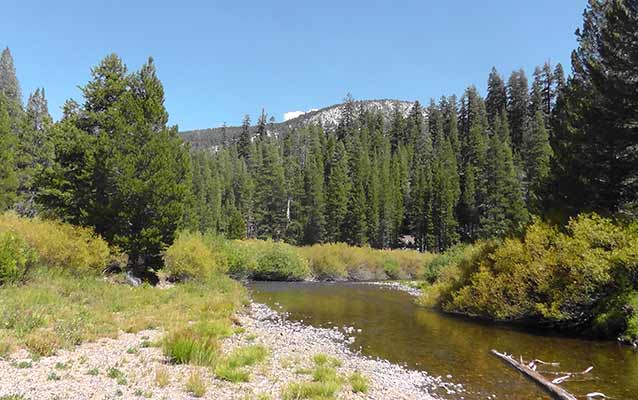Last updated: June 19, 2015
Lesson Plan
Exploring Climate Science: Stream Flow Tools and Data

- Grade Level:
- Upper Elementary: Third Grade through Fifth Grade
- Subject:
- Science
- Lesson Duration:
- 60 Minutes
- Common Core Standards:
- 5.RI.7, 5.RI.9, 5.W.8, 5.W.9
- Additional Standards:
- Next Generation Science Standards: 5-ESS2-2, 5-ESS3-1
- Thinking Skills:
- Remembering: Recalling or recognizing information ideas, and principles. Understanding: Understand the main idea of material heard, viewed, or read. Interpret or summarize the ideas in own words. Applying: Apply an abstract idea in a concrete situation to solve a problem or relate it to a prior experience. Analyzing: Break down a concept or idea into parts and show the relationships among the parts.
Objective
In “Exploring Climate Science (Streamflow Tools and Data),” students will use data to draw conclusions about climate change. The students will be able to:
1. Create a double line graph to show the changes in streamflow throughout the year
2. Make two predictions about how climate change may affect stream flows
Background
Water is essential for life on Earth. Relative water availability is a major factor in designating habitats for different living organisms. In the United States, things like agriculture and water rights are hot topics. Current models predict that average global temperatures are going to continue to rise even if regional climate changes remain complex and varied. These changes will have an impact on all of Earth's systems.
Studies have shown that climate change is driven not only by natural effects but also by human activities. Knowledge of the factors that affect climate, coupled with responsible management of natural resources, are required for sustaining these Earth systems. Long-term change can be anticipated using science-based predictive models, making science and engineering essential to understanding global climate change and its possible impacts.
National Parks can serve as benchmarks for climate science trends and effects over time because they are protected areas void of human influence. Understanding current climate trends will help set students up to be successful in interpreting and engaging in discussions about climate change, which will lead to informed decision making.
Preparation
Make copies of the student materials Streamflow Data and Worksheet 6.1. for each group. (See Materials Section)
Gather the following supplies:
-
Graph paper
- Markers
Materials
This file provides data from Pohono Bridge in Yosemite Valley. Students will use this data to draw conclusions about climate change.
This file will familiarize students with basic vocabulary for the lesson
Download Worksheet 6.1: Vocabulary review
Lesson Hook/Preview
Explain that scientists measure water flow to track climate changes just like they measure snow water equivalent. Pre-teach vocabulary: stream flow, peak flow, water level. Additionally review double line graph and bargraph if necessary.
Procedure
STEP 1:
-
Have students make predictions about what impacts stream flow.
-
Show hydrology podcast from CD (or download from materials section or website) so students can observe how scientists measure stream flow.
STEP 2
-
Explain to students that they will be graphing the stream flow from Pohono Bridge in Yosemite Valley. Model creating a double line graph using data from 2009 & 2010 (see procedure 6.1). Then, facilitate a discussion of the graph.
-
When is peak flow?
-
How are water levels different for 2009 & 2010?
-
Why is the most water released in May/June?
-
Have students create a double line graph using data from 2011 & 2012, then record two thing they notice about their graphs in relation to streamflow (on sticky notes or on the graph itself). Share observations.
-
Talk about how streamflow can give us information about climate change.
-
Measuring stream flow can give scientists a good idea of how much the snowpack is melting on a specific day or month.
-
Due to climate change the peak stream flow could begin to occur sooner in the year. This could have the potential to throw many natural systems off and could negatively impact the water availability for human use.
-
Tell students that scientists began measuring stream flows from the stream in 1960.
-
Ask: how do you think streamflow has changed over time?
-
If necessary direct student thinking…peak stream flow might occur earlier because snow melts earlier due to warmer temperatures, etc.
- Show students graph of decade averages from 1960 – 2010 (Worksheet 6.1). Talk about what the graph shows. Emphasize the importance of continuing to record information so scientists can see changes over time.
Vocabulary
-
Stream flow—the flow of water in streams and rivers often from snowpack runoff.
-
Watershed – an area of land where all of the water that is under it or drains off of it goes into the same place.
- Peak flow—the maximum flow of water in a river or stream in a given year.
Assessment Materials
Discussion: Why is monitoring streamflow important? Think about what streamflow might tell us about peak flows, water levels, climate change, etc.
Related Lessons or Education Materials
Day 1- Earth as a System
Day 2- Weather vs Climate
Day 3- Watershed
Day 4- Climate Science Data and Tools
Day 5- Field Trip
Day 6- NPS Connections
Day 7- Project Preparation
Day 8- Evaluations
